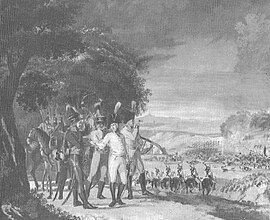Battle of Ostrach
| Battle of Ostrach | |||||||
|---|---|---|---|---|---|---|---|
| Part of the War of the Second Coalition | |||||||
 Archduke Charles and his staff at the Battle of Ostrach |
|||||||
|
|||||||
| Belligerents | |||||||
|
|
|
||||||
| Commanders and leaders | |||||||
| Archduke Charles | Jean Baptiste Jourdan | ||||||
| Strength | |||||||
| 52,000 | 28,000 | ||||||
| Casualties and losses | |||||||
| 2,113 (4%) | 2,257 (8%) | ||||||
| Digby Smith. Napoleonic Wars Databook: Actions and Losses in Personnel, Colours, Standards and Artillery, 1792–1815. Mechanicsburg PA: Stackpole, 1998, , p. 147 | |||||||
The Battle of Ostrach, also called the Battle by Ostrach, occurred on 20–21 March 1799. It was the first battle of the War of the Second Coalition. The battle resulted in the victory of the Austrian forces, under the command of Archduke Charles, over the French forces, commanded by Jean Baptiste Jourdan.
The battle occurred during Holy Week, 1799, amid rain and dense fog. Initially, the French were able to take, and hold, Ostrach and the nearby hamlet of Hoßkirch plus several strategic points on the Ostrach marsh. As the engagement began, Habsburg numerical superiority overwhelmed French defenses. By evening, the French left wing was flanked and Jourdan's men retreated from Ostrach to the Pfullendorf heights. On the next morning, as Jourdan considered a counter-attack, the weather broke, and he could look down on the Austrian battle array. The numbers and dispositions of the Austrians convinced him that any attack would be useless, and that he could not hope to maintain his position in the heights. As he withdrew, a portion of his right flank was cut off from the main force.
Although casualties appeared even on both sides, the Austrians had a significantly larger fighting force, both on the field at Ostrach, and stretched along a line between Lake Constance and Ulm. French casualties amounted to eight percent of the force and Austrian, approximately four percent. The French withdrew to Engen and , where a few days later the armies engaged again, this time with greater losses on both sides, and an .
Initially, the rulers of Europe, such as Joseph II, Holy Roman Emperor, viewed the revolution in France as an event between the French king and his subjects, and not something in which they should interfere. As the rhetoric grew more strident, however, the other monarchies started to view events with alarm. In 1790, Leopold succeeded his brother Joseph as emperor and by 1791, he considered the situation surrounding his sister, Marie Antoinette, and her children, with greater and greater alarm. In August 1791, in consultation with French émigré nobles and Frederick William II of Prussia, he issued the Declaration of Pilnitz, in which they declared the interest of the monarchs of Europe as one with the interests of Louis and his family. They threatened ambiguous, but quite serious, consequences if anything should happen to the royal family.
...
Wikipedia
